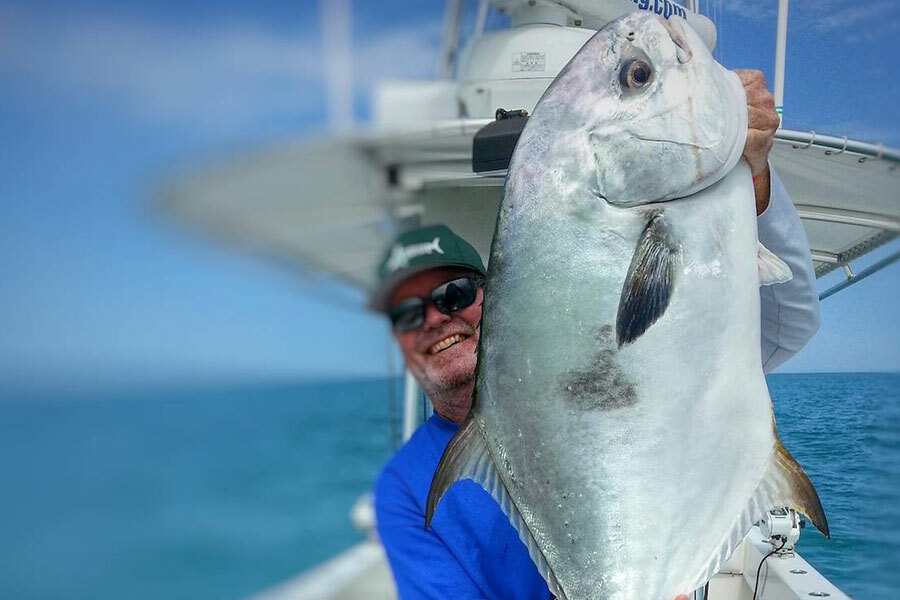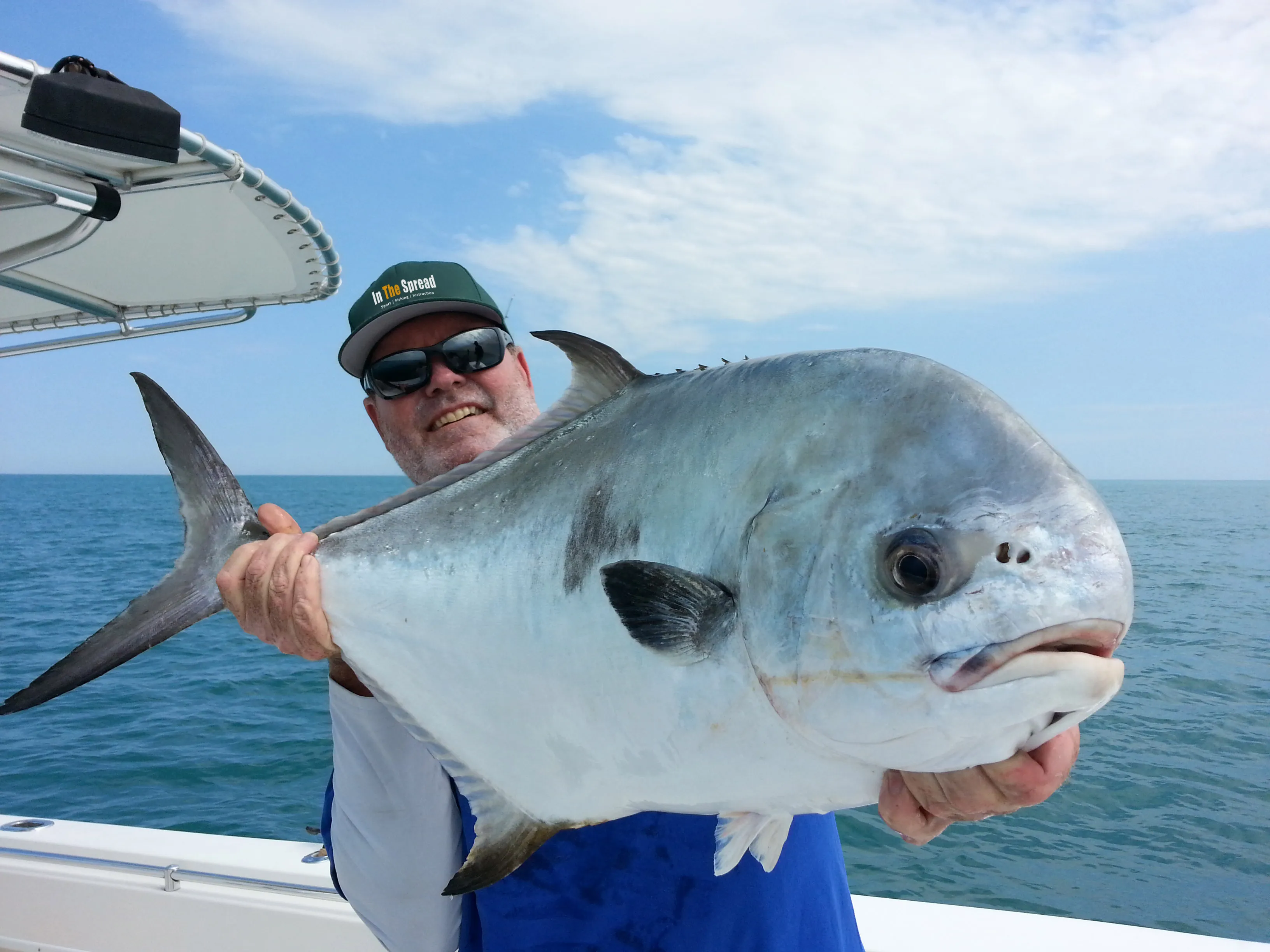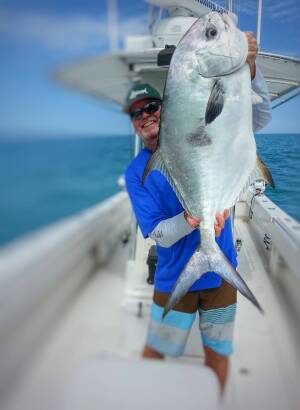The permit fish, a species of Carangidae, is found in the western Atlantic Ocean, Massachusetts to southeastern Brazil, and the Gulf of Mexico. They have a distinct shape, long snout, and small mouth, making them a valuable predator and prey in the marine ecosystem.

Permit Fish – Understanding this Wary Predator
The Permit Fish (Trachinotus falcatus)
The permit fish (Trachinotus falcatus) is a species of fish belonging to the Carangidae family, commonly found in the western Atlantic Ocean, from Massachusetts to southeastern Brazil, including the Gulf of Mexico and the Caribbean Sea. Permit fish are typically found in shallow coastal waters, flats, reefs, and seagrass beds, and they are often associated with sandy and muddy bottoms.
Permit are known for their distinct shape, which includes a deep, compressed body, a forked caudal fin, and an elongated dorsal fin. They are silver-gray in color, with a dark, bluish-black upper body that fades to a lighter silver or white on the underside. Adult permit fish can grow up to 48 inches (120 cm) in length and weigh up to 79 pounds (36 kg), although most individuals are smaller, averaging around 15-25 pounds (7-11 kg).
One of the key features of this fish is their long, blunt snout with a small, terminal mouth. This adaptation allows them to feed primarily on small crustaceans, mollusks, and other invertebrates found on the ocean floor. They are known for their strong, powerful swimming ability and are highly sought after by sport fishermen for their incredible fighting skills when hooked.
Permit fish are typically solitary or found in small schools, and they can be challenging to catch due to their skittish nature and wariness of humans. They are also known to make seasonal migrations, moving to deeper waters during colder months and returning to shallower coastal areas as the water warms. Permit fish play an essential role in the marine ecosystem, serving as both predator and prey for various species.
Taxonomy of the Permit
The permit fish belongs to the following taxonomic hierarchy:
- Kingdom: Animalia - This kingdom includes all animals, characterized by their ability to move, multicellular structure, and heterotrophic nutrition.
- Phylum: Chordata - Chordates are animals with a notochord, a dorsal nerve cord, and pharyngeal slits at some stage of their life. This phylum includes vertebrates like fish, mammals, birds, reptiles, and amphibians, as well as some invertebrates.
- Class: Actinopterygii - This class contains ray-finned fishes, which are the most diverse and numerous group of fish, with over 30,000 species. They are characterized by their bony, ray-like fin structures.
- Order: Carangiformes - This order includes a variety of carnivorous, marine fish species, such as jacks, pompanos, and trevallies. They are known for their streamlined bodies, forked tails, and strong swimming abilities.
- Family: Carangidae - The Carangidae family comprises jacks, pompanos, and related species. These fish are fast swimmers with a streamlined body shape, and they are typically found in marine environments, including reefs, open oceans, and coastal areas.
- Genus: Trachinotus - The Trachinotus genus includes pompanos, which are medium-sized, deep-bodied fish with a distinctive shape, including a forked caudal fin and an elongated dorsal fin.
- Species: Trachinotus falcatus - The permit fish is a species within the Trachinotus genus, known for its distinct shape, powerful swimming ability, and sought-after status among sport fishermen.
Predatory Instincts
This is a game fish that exhibits strong predatory instincts, allowing it to efficiently locate and capture its prey. These instincts, combined with its physical adaptations, make it a successful hunter in its marine environment.
Permits primarily feed on small crustaceans, mollusks, and other invertebrates found on the ocean floor. Their long, blunt snout and small, terminal mouth enable them to probe into the sand, mud, or seagrass beds to extract prey. They also have specialized teeth for crushing the shells of crustaceans and mollusks.
The species' keen eyesight plays a crucial role in detecting prey in the shallow waters where it is commonly found. As visual hunters, permits are effective at identifying and tracking potential food sources in the often-turbid water of coastal areas and flats.
In addition to their excellent vision, these elusive gamefish are powerful swimmers, thanks to their streamlined body and strong, forked caudal fin. Their swimming abilities allow them to swiftly close in on prey and make sudden changes in direction if needed, giving them an advantage in capturing elusive prey items.
Moreover, permit fish are known to display opportunistic feeding behaviors, adjusting their diet based on the availability of food sources in their environment. This adaptability contributes to their success as predators and helps them thrive in various habitats.
Overall, the species predatory instincts, combined with its physical adaptations and opportunistic feeding behaviors, make it an efficient and successful hunter in its natural habitat.
When and Where To Fish For Permit
The best time and locations for fishing permit vary depending on their seasonal movements and regional distribution. However, some general guidelines can help you plan your fishing trip.
Top Destinations for Permit
Locations: Fish are commonly found in the western Atlantic Ocean, ranging from Massachusetts to southeastern Brazil, including the Gulf of Mexico and the Caribbean Sea. Some of the most popular locations for targeting permit are:
- Florida Keys, United States: The shallow flats, channels, and wrecks around the Florida Keys offer prime habitat for permit, making it a premier destination for anglers.
- Bahamas: The extensive flats and crystal-clear waters of the Bahamas provide excellent opportunities for sight fishing.
- Belize: The flats and coastal areas of Belize, especially around Ambergris Caye, are known for their healthy populations of the species.
- Mexico: The Yucatan Peninsula, including areas like Ascension Bay, offers productive flats and coastal waters for fishing.
Best Times of The Year to Target Permit Fish
Timing: Permit can be found in these locations year-round; however, their abundance and behavior may change with the seasons. Some general guidelines for timing include:
- Late spring to early fall (April to September): This is generally considered the peak season for fishing in most locations, as the fish move into the shallow flats and coastal waters to spawn and feed. This is when they are most active and aggressive, offering the best opportunities for anglers.
- Winter months (December to February): During colder months, fish often move to deeper waters and can be found around reefs, wrecks, and ledges. While they may be less abundant in the shallows, they can still be targeted in deeper areas during this time.

Fishing for Permit
To successfully target fish, anglers often employ various techniques, including:
- Sight fishing: This involves spotting the fish in shallow water and casting a lure, live bait, or fly in its path without spooking it. Stealth, patience, and accurate casting are crucial for success.
- Fly fishing: Many anglers enjoy the challenge of catching permit on a fly rod, requiring skillful casting and presentation to entice the fish to strike.
- Light-tackle spinning or baitcasting: in the world of sportfishing, with anglers often using live crabs, shrimp, or small baitfish as well as artificial lures designed to mimic their natural prey.
In summary, the best time and place to fish for permit typically occur from late spring to early fall in shallow flats and coastal waters of the western Atlantic, especially in the Florida Keys, Bahamas, Belize, and Mexico. Utilizing sight fishing, fly fishing, or light-tackle spinning techniques can increase your chances of success when targeting this challenging and rewarding species.
Permit Fishing Tactics and Techniques
Remember that these fish are a challenging species to catch, so be prepared for some trial and error. Practice your casting and presentation skills, observe the fish's behavior, and adjust your tactics as needed to improve your chances of success. Catching permit (Trachinotus falcatus) can be challenging due to their wariness and selective feeding habits. To increase your chances of success, consider employing these more detailed tactics and techniques:
- Approach the fishing area stealthily, using a push pole, trolling motor, or wading to minimize noise and disturbance.
- Look for signs of tailing fish, mud plumes, or nervous water.
- Cast your bait or lure ahead of the fish, allowing it to settle before the fish reaches it. This will give the permit time to discover the bait naturally.
- Use crab or shrimp pattern flies that match the size and color of the natural prey in the area.
- Practice casting accuracy and distance, as permit can be easily spooked by poor presentations or sudden movements.
- If a permit refuses your fly, try changing the fly pattern or size, or vary the retrieve speed and technique.
- Be patient and persistent, as it may take multiple casts and presentations to entice a fish to bite.
- Use small pieces of shrimp, crab, or fish as chum, being careful not to overdo it. Too much chum can make the fish wary and less likely to bite.
- Position your boat upwind or upcurrent of the chumming location and cast your bait into the chum slick.
- Monitor the chum slick for signs of feeding fish, and adjust your bait or lure presentation accordingly.
- Identify areas likely to hold permit, such as flats, channels, or drop-offs, and drift over them while casting your bait or lure.
- Use a drift sock or sea anchor to control your drift speed if necessary.
- Adjust your drift to cover different depths or areas to maximize your chances of encountering permit.
- Locate underwater structures such as wrecks, reefs, or rock piles using your fish finder or GPS.
- Present your bait or lure near the structure, being cautious not to snag on it.
- Use a heavier leader material to help protect against abrasion from the structure.
- Plan your fishing trip around periods of strong tidal movement, as permit are often more active and feeding during these times.
- Overcast days and low-light conditions can be productive for permit fishing, as the fish may be less wary and more likely to feed.
Patience and observation:
- Be prepared to spend time searching for permit and observing their behavior before casting.
- If you are not having success with your current tactic or location, don't be afraid to switch it up and try something different.
By employing these tactics and techniques, and adjusting your approach based on the fish's behavior and conditions, you can improve your chances of successfully catching permit.
Fishing Gear
- Rods and Reels: Selecting the right fishing rods and reels for targeting permit (Trachinotus falcatus) is crucial for success, as it can improve your casting accuracy, sensitivity, and ability to handle the fish's powerful runs. There are a few options for rods and reels depending on the technique you plan to use:
- Spinning Rods and Reels: A medium to medium-heavy action spinning rod in the 7 to 8-foot range is a popular choice for permit fishing, as it provides a good balance of casting distance, accuracy, and backbone for fighting the fish. Pair the rod with a high-quality spinning reel in the 3000 to 5000 size range, ensuring it has a smooth drag system capable of handling the powerful runs of a permit.
- Line for Spinning Gear: Use braided line in the 20 to 30-pound test range for its sensitivity, thin diameter, and low-stretch properties, with a 20 to 30-pound fluorocarbon leader for added abrasion resistance and invisibility underwater.
- Baitcasting Rods and Reels: For anglers who prefer baitcasting setups, a medium to medium-heavy action baitcasting rod in the 7 to 8-foot range is suitable. Pair it with a high-quality, low-profile baitcasting reel with a smooth drag system and a line capacity suitable for the 20 to 30-pound test line.
- Line for Baitcasters: Similar to the spinning setup, use braided line in the 20 to 30-pound test range with a 20 to 30-pound fluorocarbon leader for abrasion resistance and reduced visibility.
- Fly Rods and Reels: Fly fishing requires a specialized setup. A 9 to 10-weight fly rod in the 9-foot range is typically recommended, as it provides the necessary power to cast heavier flies, such as crab patterns, and handle the strength of a hooked permit. Pair the fly rod with a large-arbor fly reel designed for saltwater use, ensuring it has a strong, smooth drag system to manage the fish's runs.
- Fly Line: Use a weight-forward floating or intermediate fly line that matches your rod weight, with a 9 to 12-foot tapered fluorocarbon leader in the 16 to 20-pound test range. For windy conditions or when casting larger flies, a shorter, more aggressive leader may be beneficial.
No matter which setup you choose, ensure all your gear is corrosion-resistant and designed for saltwater use. Regularly clean and maintain your equipment to keep it in good working condition and prolong its lifespan.
Baits and Lures for Permit Fishing
Permit fish are often selective feeders, which can make choosing the right bait crucial for success. Here is a more detailed overview of various baits used for permit fishing:
Live Bait
- Crabs: Small blue crabs or pass crabs are considered the most effective live baits, as crabs make up a significant portion of their diet. Hook the crab through the corner of its shell or one of the rear swimmerets, making sure not to damage the internal organs.
- Shrimp: Live shrimp can also be a productive bait for permit. Hook the shrimp through the horn (the area right behind the head) or through the tail, avoiding the dark spot, which is the shrimp's vital organs.
- Small baitfish: In some instances, permit may also feed on small baitfish. Species such as pilchards, pinfish, or grunts can be used as live bait. Hook the baitfish through the nose, just in front of the dorsal fin or under the spine near the tail, depending on your presentation preference.
Dead Bait
- Cut crab: Cut a blue crab or other small crab into halves or quarters, depending on its size, and use it as a dead bait. This can be effective in attracting permit, especially when used in combination with chumming.
- Cut shrimp: Fresh, dead shrimp can also be used as bait for permit. Peel the shrimp and thread it onto the hook or use it whole with the shell still on.
- Soft plastic crabs: These lures imitate the look and feel of live crabs, making them appealing to permit. Use a jig head or weighted hook to present the soft plastic crab naturally along the bottom.
- Soft plastic shrimp: Similar to soft plastic crabs, soft plastic shrimp mimic the appearance and movement of live shrimp. Rig them on a jig head or weighted hook and retrieve them with a slow, steady action or small hops along the bottom.
- Jigs: Small jigs in natural colors that mimic the appearance of crustaceans or baitfish can be effective for permit fishing. Choose a jig with a weighted head to help maintain contact with the bottom, and use a slow, hopping retrieve.
When fishing, it's essential to present your bait as naturally as possible. For live baits, this often means free-lining or using a light weight to keep the bait near the bottom. With artificial lures, mimic the movement of the prey you are imitating and adjust your retrieve speed and technique based on the fish's behavior.
Florida Fishing Regulations
The Florida Fish and Wildlife Conservation Commission (FWC) has established certain regulations for the harvest of permit (Trachinotus falcatus) in Florida state waters. It is important to note that these regulations may change over time, and it is always advisable to consult the FWC's website or contact them directly for the most up-to-date information before fishing.
According to the FWC, the following regulations applied to permit fishing in Florida:
- Size limit: There is a minimum size limit of 11 inches (28 cm) for permit with a fork length in Florida state waters, except in the Special Permit Zone (SPZ).
- Bag limit: The daily bag limit for permit outside the SPZ is two fish per person or six fish per vessel, whichever is less.
- Special Permit Zone (SPZ): The SPZ covers the area south of Cape Florida in the Atlantic and south of Cape Sable in the Gulf of Mexico. In the SPZ, permit must have a minimum fork length of 22 inches (56 cm) to be harvested, and the daily bag limit is one fish per person or two fish per vessel, whichever is less.
- Seasonal closure: There is a seasonal closure for the harvest of permit in the SPZ from April 1 to July 31, during which time the capture and possession of permit in the SPZ is prohibited.
- Gear restrictions: The use of certain gear types, such as longlines, gill nets, and trawls, is prohibited for the harvest of permit. Anglers are generally allowed to use hook and line, cast nets, and spearfishing gear (where spearfishing is permitted).
These regulations are designed to protect and conserve permit populations while ensuring sustainable recreational fishing opportunities. Keep in mind that regulations may change, so always check with the FWC for the most current information before heading out to fish. Seth Horne In The Spread, Chief Creator











